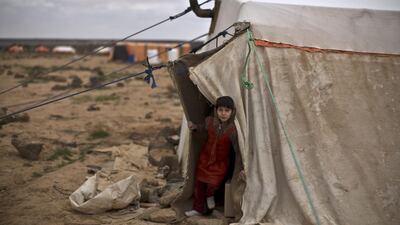AMMAN // A polar front sweeping Jordan this week is exacerbating the misery of hundreds of thousands of Syrian refugees struggling to cope with biting cold, high winds, snowfall and heavy rain.
The harsh weather conditions started on Saturday and intensified on Sunday, bringing temperatures to below zero. A significant drop in temperatures in the next few days is expected and will plunge temperatures to minus 8-10°C below their annual average, said Ayman Sawalha, the chief meteorologist at ArabiaWeather.
“Snow is expected to reach between 20-30cm deep in major cities and the temperatures in Amman will drop to minus five and lower in the rural areas,” he said.
The Greater Amman Municipality has declared a state of emergency and dispatched 37 snowplows, some with salt spreaders in several parts of the capital. The Civil Defense Department urged people to stay away from wadis in case of flooding and to avoid driving. There have been no major roads blocked so far, but some universities have announced two days off.
But the worst effects from the cold weather are being felt by the hundreds of thousands of Syrian refugees who have flooded Jordan during five years of war.
Musa a refugee from Homs who lives in an informal settlement in Mafraq with his wife and five children, said his family is trying hard to stay warm.
“We don’t have wood to keep us warm and my children are all sick. They have a cold including Ashwaq,” he said, referring to his newborn daughter suffering from a cough. “The day before yesterday, part of the tent fell and I had to fix it under the pouring rain and mud. I’ll have to leave things to God,” he said. His wife Yusra said the family is surviving on bread.
In Jordan, there are 1.4 million Syrians, 635,000 of which are registered with the UNHCR. The vast majority of refugees live in the urban communities, many in unfinished apartments with cardboard or plastic blocking holes where windows or doors should be. Many are already struggling to pay rents and put food on the table as limited aid by the UN agencies is making it tougher to sustain their living.
Huda, a Syrian widow and a mother of six who lives in an apartment in Ramtha, said: “We hardly turn the gas heater on, trying to save it till the night so we don’t run out of gas. We have wrapped ourselves in blankets to stay warm. We live from day to day. And the food coupons don’t last long. My son is asking for eggs and we don’t have any.”
Zaatari camp, Jordan’s fourth largest city, is home to 80,000 refugees. The pouring rain has made the rugged roads muddy. Ahead of the storm, refugees have insulated their mobile huts provided by aid agencies and other donors.
Ahmad Ibrahim, a 27-year-old refugee in Zaatari said refugees have prepared themselves for the weather. “It is not the first time we have bad weather,” he said. “We have learnt to cope. The roads are rough and muddy so I had to buy boots, a jacket and a gas cylinder for the heater. But
the boots I bought first leaked water, so I had to buy a plastic boots.”
A 23-year old refugee in Azraq refugee camp, home to 30,000 refugees, said he, his wife and daughter are surviving on nearly US$90 (Dh330) a month from World Food Programme food vouchers and prepaid credit cards that enables them to shop for their main groceries. They also have blankets and three mattresses in their caravan, a gas heater and a solar lamp. There is no electricity at the camp. As soon as the credit runs out, they survive on bread and tea, he said.
“We have six blankets, but we are not warm, what can we do? We have to put up with the cold.”
Andrew Harper, the head of the United Nations refugee agency in Jordan said UN aid agencies have distributed blankets and heaters in preparation for the storm and ensured that the drainage channels are clear at the Zaatari camp, but said the refugees living outside the camps fare worse.
“In the camps, refugees have more support and shelter than those living in rundown apartments outside, with plastic covering windows or they cannot afford heating,” he said. “We have been working with the refugees groups outside the camps we have provided cash assistance for the most vulnerable,” he said. “There is nothing worse than seeing a child shivering when you have a storm coming through”.
foreign.desk@thenational.ae

